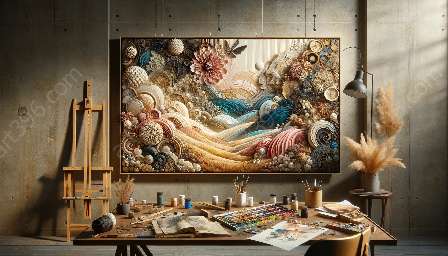As we explore the role of collaboration in creating mixed media art, it's essential to understand how this practice is compatible with future trends and the broader field of mixed media art.
The Process of Collaboration in Mixed Media Art
Collaboration in mixed media art involves the coming together of artists from different backgrounds, skills, and perspectives to work on a single artwork or a series of works. This involves artists contributing their expertise in various mediums, such as painting, sculpture, digital art, and more, to create a rich and diverse artistic expression.
Artists engaged in collaboration often exchange ideas, techniques, and materials, leading to the fusion of different styles and approaches. The process is dynamic, as it allows for the blending of traditional and contemporary methods, resulting in a truly unique and innovative artistic outcome.
The Benefits of Collaboration
Collaboration in mixed media art offers numerous benefits. Firstly, it provides an opportunity for artists to learn from each other, expanding their knowledge and skills in different artistic disciplines. This exchange of expertise and experience fosters a culture of continuous learning and growth within the artistic community.
Furthermore, collaboration encourages experimentation and exploration of new artistic territories. Artists are often pushed to step out of their comfort zones and embrace unfamiliar techniques and materials. This willingness to take risks and venture into uncharted creative territories can lead to groundbreaking artistic discoveries and innovations.
Collaboration also promotes inclusivity and diversity in art. By bringing together artists from varied backgrounds and cultures, mixed media art becomes a platform for cross-cultural dialogue and understanding. This diversity enriches the artistic landscape, allowing for the expression of different narratives, experiences, and perspectives.
The Impact of Collaboration in Mixed Media Art
The impact of collaboration in mixed media art extends beyond the artistic sphere. It has the potential to foster community engagement and social change. Collaborative art projects often involve the participation of local communities, leading to the creation of art that reflects and addresses social issues, traditions, and values.
Moreover, collaboration can contribute to the economic growth of artistic communities. By facilitating partnerships and joint ventures, artists can combine their resources and networks, leading to increased exposure, opportunities, and potential for financial sustainability.
Compatibility with Future Trends in Mixed Media Art
The role of collaboration aligns with emerging trends in mixed media art. With advancements in technology and the increasing interconnectedness of the global art world, collaboration becomes more feasible and accessible than ever before. Digital platforms, online communities, and social media enable artists to connect and collaborate across geographical boundaries, facilitating the exchange of ideas and the co-creation of artworks.
Furthermore, future trends in mixed media art indicate a growing emphasis on interdisciplinary approaches and the convergence of various artistic disciplines. Collaboration naturally fits into this landscape, as it encourages interdisciplinary exchange and the integration of diverse artistic practices.
Additionally, as the art world becomes more conscious of sustainability and environmental impact, collaboration can serve as a catalyst for eco-friendly art creation. By sharing and repurposing materials, minimizing waste, and adopting sustainable practices, collaborative art projects can contribute to a greener and more responsible artistic ecosystem.
Conclusion
Collaboration plays a pivotal role in the creation and evolution of mixed media art. Its process, benefits, and impact demonstrate its compatibility with future trends in the field. As artists continue to embrace collaboration, they pave the way for a more inclusive, innovative, and sustainable artistic future.

